The Kingdom of Sukhothai had important contacts with Sri Lanka. Thai monks travelled to Sri Lanka for further religious instruction, and Sri Lankan monks settled in Sukhothai. Sukhothai religious art was thus influenced by Sri Lankan art. The Buddha images of the Sukhothai era gained important disdinguishing characteristics from the images during the Khmer and Mon era.
A flame appeared on top of the head of the Buddha. The head is covered with fine curled hair. The face is oval, with high curving eyebrows, a hooked nose, a downward gaze, and overall displays a gentle smiling expression.
The body of the Buddha images displays broad shoulders and a small waist.
Overall it can be said that the Buddha Images do not appear human, but display idealistic or superhuman characteristics.
During the Sukhothai era, the four postures of the Buddha (sitting, standing, walking, reclining) were created.
Buddha images of the Sukhothai era are subdivided in several groups.
The image right below here displays Phra Phuttha Chinnarat image in Phitsanulok. It belongs to the Phra Phuttha Chinnarat group of images. Notice that the face is more rounded with a flame shaped aureole. The fingers on each hand are of equal lenght.
Sitting Buddha images of the Sukhothai period most often display meditation posture, or the gesture of Subduing Mara. Walking Buddhas display the gesture of dispelling fear (Abhaya Mudra), or giving instruction (Vitarka Mudra).
 | | Phra Phuttha Chinnarat at Wat Phra Sri Rattana Mahathat in Phitsanulok.
This Buddha image is generally regarded to be the 'second most' important Buddha image in Thailand.
[The Emerald Buddha at Wat Phrakaew in Bangkok is probably the most important]
A replica of Phra Phuttha Chinnarat is present as the main Buddha image at Wat Benchamabophit in Bangkok. | |
 | Standing Buddha, with the gesture of forbidding the relatives from fighting each other.
In the style of the Sukhothai period.
Found at Wat Bang Oi Chang, Nonthaburi province.
Image present in the cloister of the Ubosoth at Wat Benchamabophit, Bangkok. | |
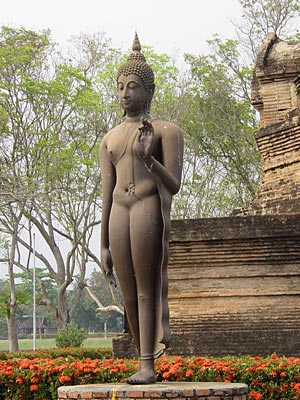 | | Walking Buddha, Sukhothai Historical Park | |
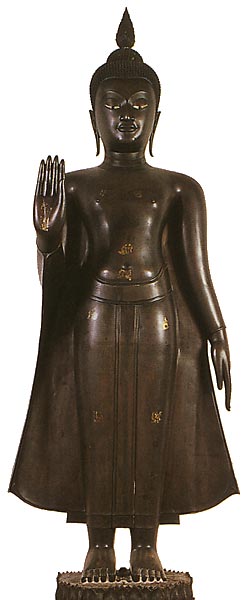 | | Standing Buddha image, with the gesture of Forbidding the Relatives from Fighting.
In the style of the Sukhothai period.
Found at Wat Mai Nakhon Luang, Ayutthaya province.
Image present in the cloister of the Ubosoth at Wat Benchamabophit, Bangkok. | |
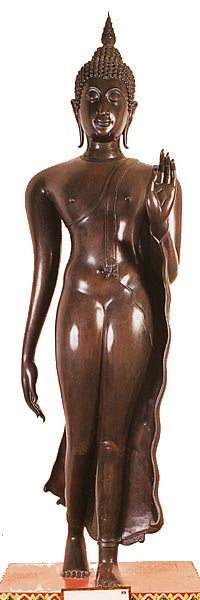 | | Walking Buddha image with the gesture of Imparting Fearlessness.
In the style of the Sukhothai period.
From Wat Mahathat, Bangkok.
Image present in the cloister of the Ubosoth at Wat Benchamabophit, Bangkok. | |
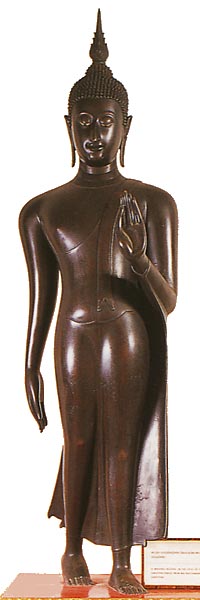 | Walking Buddha, with the gesture of Imparting Fearlessness.
In the style of the Sukhothai period.
From Wat Ratchathani, Sukhothai province.
Image present in the cloister of the Ubosoth at Wat Benchamabophit, Bangkok. | |
 | Standing Buddha image, with the gesture of Imparting Fearlessness.
In the style of the Sukhothai period.
Cast and enlarged from an ancient model.
Image present in the cloister of the Ubosoth at Wat Benchamabophit, Bangkok. | |
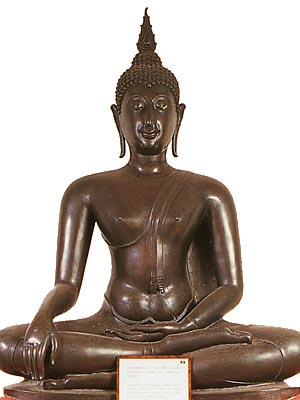 | Sitting Buddha image, with the gesture of Subduing Mara.
In the style of the Sukhothai period.
Found at Wat Praya Krai (Jotanaram), Bangkok.
Image present in the cloister of the Ubosoth at Wat Benchamabophit, Bangkok. | |
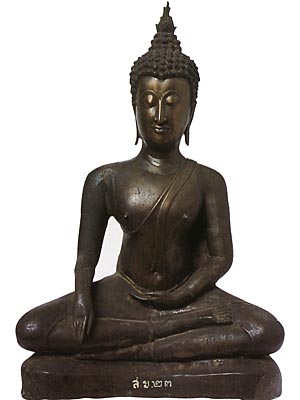 | | Buddha Image with the Gesture of Subduing Mara.
(15th century A.D.)
National Museum Prachinburi | |
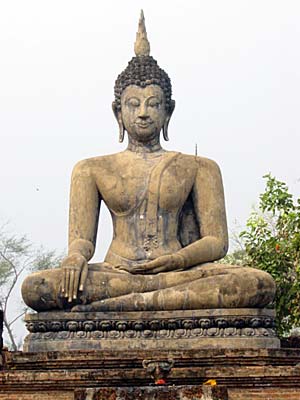 | | Buddha at Wat Mahathat, Sukhothai | |























